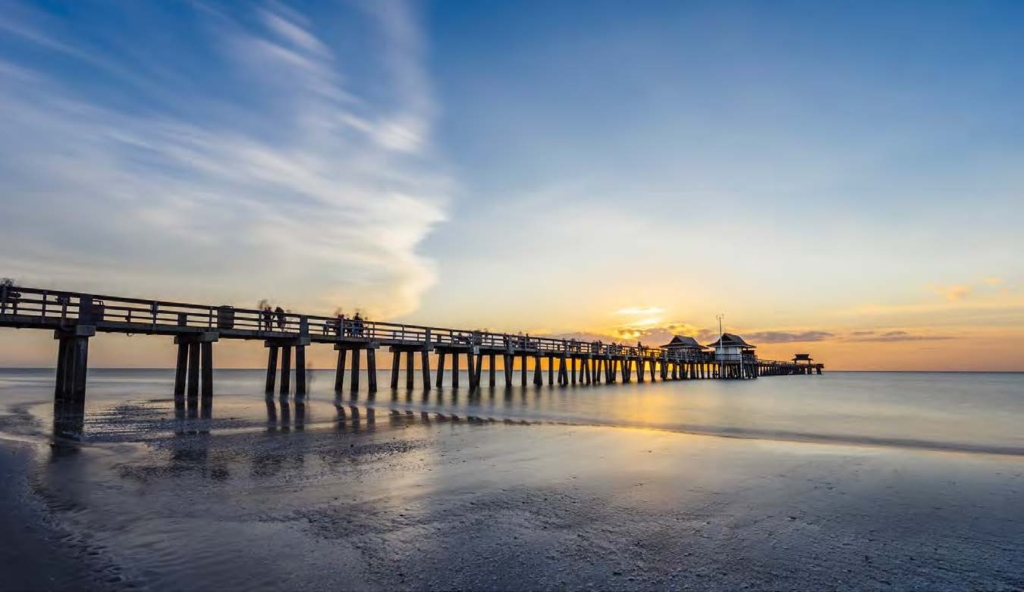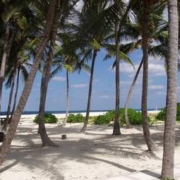The Naples Pier Timeline by Lila Zuck, Naples Historical Society Historian
 1888 – Construction of the 600 foot Naples Pier was completed.
1888 – Construction of the 600 foot Naples Pier was completed.
1901 – A small wooden structure on stilts was built at the northeast end of the pier where passengers registered after disembarking.
1910 – The hurricane of 1910 destroyed the original 1888 Naples Pier and it was rebuilt. The new pier was stronger and 400 feet longer, extending 1,000 feet out into the Gulf of Mexico.
It terminated in the shape of a southward extending “L” alongside of which boats moored. A derrick was constructed to hoist heavy baggage and the 200 pound blocks of ice that still came to Naples by boat from Fort Myers. A lamp post at the entrance to the pier was powered by a generator. A narrow gauge tram track was installed along the length of the pier leading to the Hotel Naples, along which luggage and blocks of ice were transported to the hotel in a cart with wheels.
A new lower level, or “drop dock”’ was added beneath the pier, where passengers disembarked and freight was unloaded at low tide. It was also a perfect springboard for diving into the Gulf. A red glass-paned kerosene lantern was placed on a post at the end of the pier to guide boat captains on their approach to the structure in the dark.
1926 – The pier was damaged by a hurricane and was rebuilt. New features added to the pier’s design were balconies and wings placed at intervals along the upper deck that extended out over the water.
1929 – Beginning this year, the pier served as a dance hall in the early evenings. Two-by-fours were laid across the two-by-eight inch planks at the west end of the pier. They were covered with regular pine flooring to create a dance floor, on which cornmeal was sprinkled to make the surface slick enough for dancing.
A portable Columbia Victrola in a three-sided sound box was placed at the west end of the pier. The sound box was built to direct the music outward towards the dance floor, which fishermen were kindly instructed to keep free of fish, as everyone danced the Swing. The sound box was also just large enough for a fiddler to squeeze into, when he played music to accompany the square dancers. In those days there wasn’t any air-conditioning, so the whole town socialized on the pier each evening amidst the refreshing Gulf breezes.
1937 – The Federal Government established a widespread 24 hour communications network, designed to warn ships at sea and points ashore of approaching hurricanes.
Cables were extended between the seacoasts of Brownsville, Texas and Jacksonville, Florida, and were linked by radio and telegraph communication to the islands of the West Indies. Weather condition alerts were received four times a day from ships in the South Atlantic Ocean, the Caribbean Sea, and the Gulf of Mexico.
Prior to this ruling, ships had been reporting weather conditions to the National Weather Bureau at Washington, D. C. only once a day. The National Weather Bureau office at Miami officially designated the period between June 16th and November 16th as “hurricane season.” Town Council authorized the purchase of a boat that year, to be tied to the Naples Pier and kept there for emergency rescue use. During World War II a submarine lookout station was built on the pier and manned by residents.
1944 – A hurricane completely destroyed the pier and it had to be rebuilt.
1945 – A hurricane destroyed the pier causing the need for once again the pier to be rebuilt.
1948 – Pier restrooms were constructed causing quite a fuss. Hotel Naples guests complained that the view of the Gulf from the hotel veranda had been obstructed by the restrooms. They were also dissatisfied with their color, described as bright railroad red. Easter sunrise service began being held at the west end of the pier.
1948 – Naples Town Council leased the pier to private individuals to operate concessions. They were charged $50 a month, plus $3 a week to cover the town’s cost of cleaning the restrooms.
1952 – The 18 member newly organized Junior Woman’s Club, among its many other civic contributions, sponsored the Fourth of July celebration at the pier.
1953 – City Council passed an ordinance prohibiting the use of bicycles or motor vehicles on the pier. Spear fishing or “gigging” within a radius of 100 feet around the pier was also prohibited.
1959 – The submarine U. S. S. Marlin pulled up alongside the pier and was on public display for two days in honor of Armed Forces Day. The public was invited aboard.
The first dual city shark fishing contest in the nation was held on the Naples Pier. The competing teams were the Palm Beach Sharkers and the Naples Shark Club. The wild event, which lasted an entire two day weekend, drew hundreds of spectators, who watched in awe as fishermen, running eastward alongside the length of the pier, dragged their catches across the water until they reached the beach, where the shark was permanently subdued.
1960 – In July of this year, for fear that children would be impaled on the pier’s broken and barnacle encrusted pilings, diving from the pier became unlawful. The pier was destroyed by Hurricane Donna and had to be completely rebuilt.
1961 – Consideration was given to holding a referendum to let the voters decide whether to rebuild the pier on one of two vacant lots on either side of the west end of Fifth Avenue. As public opposition to its relocation mounted, the city never purchased the lots and the pier was rebuilt at the west end of 12th Avenue South,
where it had been since 1888. Mr. and Mrs. Lester Norris funded the major part of the pier’s reconstruction.
Two fish cleaning stands with running water and racks for holding fishing rods were constructed in the center of the pier. Benches were installed at four foot intervals along the guard rails.
1963 – After attempts to regulate the sport, Naples City Council adopted an ordinance banning shark fishing from the Naples Pier. Apart from being a dangerous sport on a recreational pier, the snagged sharks were damaging the pier’s pilings as they were dragged while still hooked, alongside the structure and onto the beach.
1966 – The pier was beginning to sway. The pilings, which were promoted as being resistant to decay when purchased from South America by Lester Norris in 1961, had begun to deteriorate. In an attempt to strengthen the pilings, cement was poured into forms, or boots, that were wrapped around their bases and allowed to
harden.
1967 – Once again in honor of Armed Forces Day a submarine, the U. S. S. Mackerel this time, visited Naples. Similar to the U. S. S. Marlin in 1959, it docked alongside the pier and welcomed the public to climb aboard.
1971 – Two hundred Naples residents packed the council chamber on January 6th and expressed their opposition to City Council’s consideration to adopt an ordinance, endorsed by the 1,900 – member Naples Civic Association, imposing a 25 cent admission charge to the pier. Having failed to prevent its adoption, residents, extremely upset by Council’s decision, and many of whom were high school students, circulated a “Pier- Fee or Free” referendum petition. They obtained 1,637 signatures, well more than the 816 required by City Charter for an issue to go to referendum and the decision was placed in the hands of the electors.
The doors to the City’s five precincts opened to the City’s 6,611 voters the morning of March 30, 1971, and after the votes were tallied, “Free” prevailed and the ordinance was reversed. The only revenue the City has ever derived from the Naples Pier was and still is from leasing its concession. In 1971, the pier concessionaire’s rent was $2,880 annually.
1972 – Florida Secretary of State Richard Stone unveiled a marker designating the Naples Pier a State Historical Site.
1995 – The pier was rebuilt for the first time since 1961.
1996 – A second crossbar was installed along 600 feet of the western side of the Naples Pier after a three-year-old child slipped through the space between the railings. The Bench Memorial Program was established at that time.
2002 – Security cameras were installed at the City Dock and the Naples Pier.
2015 – The pier underwent major renovations and upgrades to enable it to withstand gale force winds.
 Naples Historical Society is the Central Voice of Naples History and operates Historic Palm Cottage™ a 3500 square foot house museum opened to the public throughout the year. This article is part of the Society Sage Stories series prepared exclusively for this publication. It is based primarily on the book Naples, A Second Paradise: The History of Naples, Florida (2010). For more information go to www.NaplesHistoricalSociety.org.
Naples Historical Society is the Central Voice of Naples History and operates Historic Palm Cottage™ a 3500 square foot house museum opened to the public throughout the year. This article is part of the Society Sage Stories series prepared exclusively for this publication. It is based primarily on the book Naples, A Second Paradise: The History of Naples, Florida (2010). For more information go to www.NaplesHistoricalSociety.org.




Leave a Reply
Want to join the discussion?Feel free to contribute!